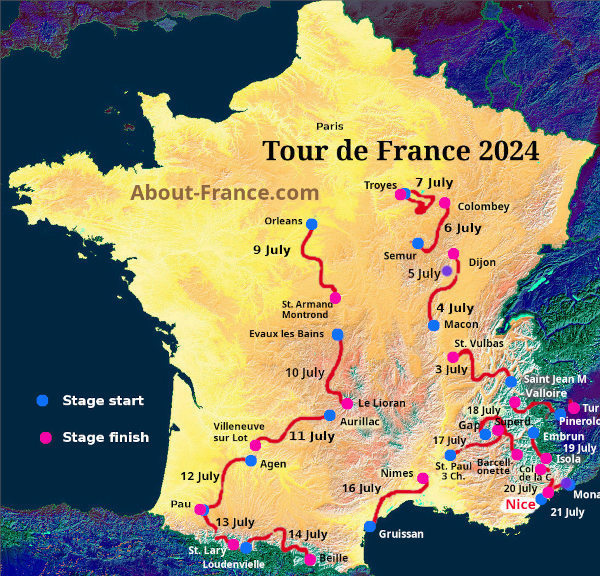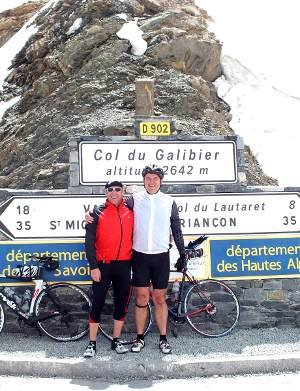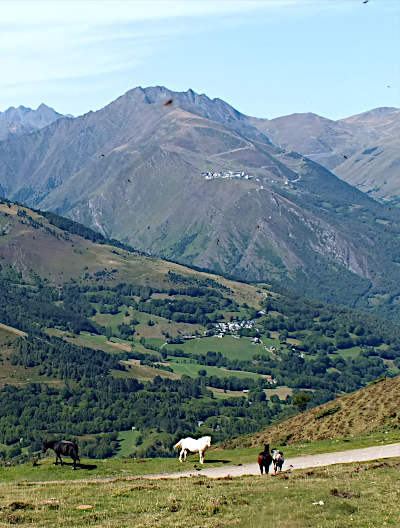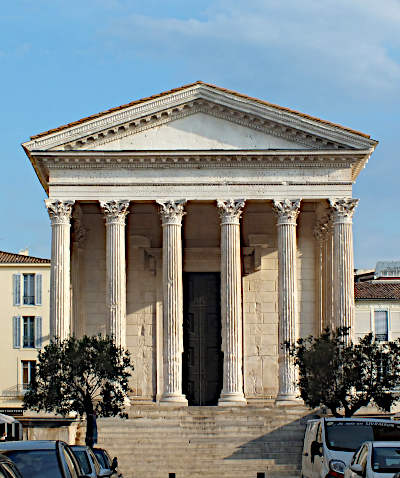
The Tour de France 2024
A Tour like never before
- Explore France ►
- Essential pages
- Travel in France
- Where to go
- What to see and do
About-France.com
- the connoisseur's guide to France
| Go to ► | The 2024 Tour de France stage by stage | Tour de France Route map |
Find hotels in France |
Site
search
About-France.com
The Tour de France 2024
For the first time in its history, the Tour de France will not be finishing in Paris. In fact, the nearest it will get to Paris is for a day on the roads and offroad tracks in the countryside near Troyes, in Champagne, and a departure for the next stage from Orleans, as the riders head south towards the Pyrenees. It also takes in the highest passes in each of the three highest mountain ranges in France, the Alps, the Massif Central and the Pyrenees.Stage details below
Le Tour 2024 - A GUIDE TO THE ROUTE
 Tour
de France route map by About-France.com
Tour
de France route map by About-France.comDetailed
map - click for regional tourism info
Copyright
: If
you copy this map on your blog or non-commercial website, you must
credit it to About-France.com
Furthermore, there'll be no symbolic sprint to the final finish line, but tensions up to the final day when the second time trials can change the final results.
For Parisian cycling enthusiasts, 2024 will be a disappointment, as the riders will not even come within 100 km of the capital, the closest points being on Sunday 7th July, when the 9th stage starts and finishes in the historic city of Troyes, 140 km to the east of Paris in Champagne, or the start of the 10th stage two days later, when riders set off from Orleans, 120 km south of Paris, on their long journey to the Pyrenees.
As in most recent years, the 2024 Tour starts off outside France, this time in the fabulous Italian city of Florence. Riders will spend three and a half days in Italy, before crossing the Alps into France during stage 4 as they head for a finish at the ski resort of Valloire after a gruelling climb to the 2,642 metre high Galibier pass where there may still be snow beside the road in early July.
After heading out of the Alps on day 5, towards Lyon, riders will then spend the next two days in the Saône valley and Burgundy wine areas (see stage 6 detailed route map), where stage 7 will take them on time trials past some of the greatest vineyards in France.
Stage 8 (see detailed stage map) takes riders from the small town of Semur-en-Auxois, near Auxerre in northern Burgundy, eastwards to Colombey-les-deux-Eglise, a village whose name is eternally linked to that of General de Gaulle, whose family had their country residence there. The following day, stage 9, is likely to be interesting, as the 199 km circuit in the countryside to the east of Troyes includes 14 off-road sections, with cyclists facing dust or mud (depending on the weather) and thrills and spills on the "white roads", gravel tracks through the fields and vineyards of the area.
After a rest day in Orleans on Monday 8th July, stage 10 (see detailed stage map) is a fairly flat ride south across the forests of the Sologne, via Vierzon and Issoudun and the great Abbey of Noirlac, to finish at Saint Armand Montrond, which prides itself as being at the geographic centre of metropolitan France.
The following day, stage 11 (see detailed stage map) will take them from Evaux les Bains in the Creuse department, through the high Limousin area and into the Cantal, with a long climb from Ydes to the Pas de Peyrol at 1589m, the highest pass in the Massif Central, then down and up again for a finish at the skiing and hiking resort of Le Lioran.
Stage 12 (see detailed stage map) crosses the southwestern slopes of the Massif Central from Aurillac passing the historic and spectacular cliffside shrine of Rocamadour, past the bastide town of Montflanquin and on to Villeneuve sur Lot. Stage 13 (see detailed stage map), from nearby Agen on the river Garonne, the French capital of prunes, is an undulating ride across the plains and hills of Gascony as far as Pau, in the foothills of the Pyrenees. After that, the going gets tough again.
As riders set off from Pau at the start of stage 14, (see Pyrenean stages map) some will be hoping for a miracle as they pass through Lourdes and prepare for one of the classic climbs of the Tour de France, the ascent to the Col du Tourmalet. Though it's not as high as the Galibier, the pull up to the top of the pass at 2115 metres, after a day's start at just 200 metres, takes it out of even the best hill climbers. And that's just a start; after the Tourmalet, there are two more steep climbs before the day's finish at Saint-Lary-Soulan, at 1669 metres. Although on the following day, stage 15, there's no climb as long and as high as the road up to the Tourmalet, riders face another gruelling challenge, with five passes between the start at Loudenvielle and the finish at the Plateau de Bielle – a classic Pyrenean stage.

Nice - exceptional end point of the Tour de France in 2024
The last five days of the Tour will take riders on a tour of inland Provence. Starting from the pretty little town of Saint Paul Trois Châteaux (which, for the record, does not have three castles), the route of stage 17 heads east through the hills of inland provence, past lavender fields and olive groves of Nyon, through the foothills of the Provençal Alps, then up into proper mountain terrain for a finish at 1500 metres at Superdevoluy. On day 18, after looping to the north from the start at Gap, over the Col du Festre at 1441 metres and down through the spectacular Défilé de la Souloise gorge to the Barrage du Sautet, riders head southeast through the Alpine foothills, past the lac de Serre-Ponçon and on to Barcelonnette.
Stage 19 is another high mountain day when the route follows close to the Italian border, taking in three peaks, including the Cime de la Bonette (Restefond) which, at 2802 metres, is the highest pass (not the highest road) in Europe – last visited by the Tour in 2008. The day's work finishes at Isola 2000, one of the higher and sunniest ski resorts in France.
As if that wasn't enough, riders get taken down to the coast at Nice for the start of the next stage, stage 20, only to have to head back into the Alps for another day's mountain stage, with three passes at over 1500 metres and a finish at 1678 metres at the Col de la Couillole. After that, the final day of time trials between Monaco and Nice will feel, for many, like a walk in the park, and a very attractive one too, taking in the dramatic corniche road overlooking the Mediterranean, through La Turbie and Eze, before dropping back down to Villefranche sur Mer and on into Nice. Riders will come past the Old Port, then along the seafront (Promenade des Anglais), and back, for a finishing line in Place Masséna.
This will be a Tour to remember.
Accommodation for the Tour
de France
All hotel rooms in and around the start and finish points get booked up very fast by the teams and the media.
To avoid disappointment, check out available hotel rooms as soon as possible, using the major online portals booking.com or Hotels.com ,
All hotel rooms in and around the start and finish points get booked up very fast by the teams and the media.
To avoid disappointment, check out available hotel rooms as soon as possible, using the major online portals booking.com or Hotels.com ,
Tour de France 2024 -stage details
The 2024 Tour de France starts on Saturday 29th June in Florence, Italy.Click links for guides to the areas and towns in France along the route of the 2024 Tour de France.
| Stage | Date | Day’s route (towns, areas) | Length in Km. |
| 1st stage | Sat 29th June | Florence to Rimini (Italy) | 206 |
| 2nd Stage | Sun 30th June | Cesenatico to Bologna (Italy) | 200 |
| 3rd Stage | Mon 1st July | Piacenza to Turin (Italy) | 229 |
| 4th Stage | Tue 2nd July | Pinerolo (Italy) to Valloire (Rhône Alpes) | 138 |
| 5th Stage | Wed 3rd July | Saint-Jean-de-Maurienne to Saint-Vulbas near Lyon (Rhône Alpes) | 177 |
| 6thStage | Thu 4th July | Macon to Dijon
(Burgundy) see Detailed route map |
163 |
| 7th Stage | Fri 5th July | Time trials: Nuits-Saint-Georges to Gevrey-Chambertin (Burgundy) | 25 |
| 8th Stage | Sat 6th July | Semur-en-Auxois (Burgundy) -
Colombey-Les-Deux-Eglises (Lorraine) see Detailed route map |
176 |
| 9th Stage | Sun 7th July | Around Troyes (Champagne) | 199 |
| Rest day | Mon 8th July | Rest day Orleans (Centre - Val de Loire) | |
| 10th Stage | Tue 9th July | Orleans to Saint Amand Montrond (Centre - Val de Loire) see Detailed route map |
187 |
| 11th Stage | Wed 10th July | Evaux les Bains (Limousin)
to Le Lioran (Massif Central) see Detailed route map |
211 |
| 12th Stage | Thu 11th July | Aurillac (Auvergne)
to Villeneuve sur Lot (Nouvelle
Aquitaine) see Detailed route map |
204 |
| 13th Stage | Fri 12th July | Agen (Nouvelle
Aquitaine) to Pau (Gascony) see Detailed route map |
171 |
| 14th Stage | Sat 13th July | Pau to Saint Lary Soulan (Pyrenees) see Pyrenean stages map |
152 |
| 15th Stage | Sun 14th July | Loudenvielle to Plateau de Beille (Pyrenees) see Pyrenean stages map |
198 |
| Rest day | Mon 15th July | ||
| 16th Stage | Tue 16th July | Gruissan to Nimes (Languedoc) | 187 |
| 17th Stage | Wed 17th July | Saint Paul Trois Châteaux to Superdévoluy (Rhône Alpes) | 178 |
| 18th Stage | Thu 18th July | Gap to Barcelonette (High Provence) | 179 |
| 19th Stage | Fri 19th July | Embrun to Isola 2000 (High Provence) | 145 |
| 20th Stage | Sat 20th July | Nice to Col de la Couillole (Provence) | 133 |
| 21st Stage | Sun 21st July | Time trials: Monaco to Nice (High Provence) | 35.2 km |

For the record:
Routes of the
Tour de France 2008 : Tour de France 2009
Tour de France 2010 Tour de France 2011
Tour de France 2012 Tour de France 2013
Tour de France 2014 Tour de France 2015
Tour de France 2016 Tour de France 2017
Tour de France 2018 Tour de France 2019
Tour de France 2020 Tour de France 2021
Tour de France 2022 Tour de France 2023
Routes of the
Tour de France 2008 : Tour de France 2009
Tour de France 2010 Tour de France 2011
Tour de France 2012 Tour de France 2013
Tour de France 2014 Tour de France 2015
Tour de France 2016 Tour de France 2017
Tour de France 2018 Tour de France 2019
Tour de France 2020 Tour de France 2021
Tour de France 2022 Tour de France 2023
Visit the Official site of the tour de France
A brief introduction to the regions of France
Copyright
© About-France.com 2007 - 2023 except where otherwise stated.
About-France.com
Home
page - Regions
- Maps of France
- Contact

Col du Galibier in late June


Old houses in the centre of Troyes

Rocamadour, in the Lot department.

In the Pyrenees - up over cols, down into valleys

The Roman "Maison Carré" in Nimes, one of the best preserved Roman buildings anywhere, and recently added to UNESCO's list of World Heritage sites.
Photo top of page by Rob Wingate.
Troyes by Serge Boutrou
Other photos About-France.com
.
France
you don't know...
Discover Offbeat France, a selection of wacky sites and attractions that most visitors have never heard of !.
Discover Offbeat France, a selection of wacky sites and attractions that most visitors have never heard of !.
Click here for
low-cost car hire in France
low-cost car hire in France

